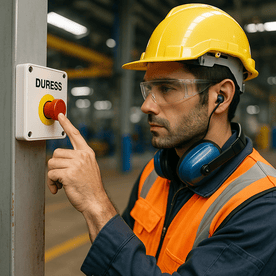
In large industrial and manufacturing environments, emergency response isn’t just about alarms and sirens—it’s about fast, silent, and strategic communication. That’s where modern duress systems come in.
Traditionally, panic buttons were simple push-and-alert devices—often outdated, hard to locate, or rarely tested. But in 2025, “smart” duress systems are changing how industrial sites protect workers, deter threats, and coordinate real-time response.
Whether you oversee a chemical plant, automotive factory, food processing facility, or distribution center, this article will walk you through what’s new, why it matters, and how to evaluate the right system for your operation.
k
k
🆘 What Is a Smart Duress System?
A duress system allows employees to instantly signal for help in the event of:
-
Workplace violence
-
Medical emergencies
-
Intruders or active threats
-
Isolated worker incidents
A smart duress system takes that basic alert function and layers it with:
-
Location tracking
-
Integrated video feeds
-
Automated workflows
-
Multi-channel alerts
-
Cloud-based event logs
These tools transform a simple button press into a coordinated, data-rich security event.
k
k
🚨 What’s New in 2025: Duress System Innovations
1. Pinpoint Location Accuracy
Modern duress systems use BLE beacons, UWB (ultra-wideband) technology, or Wi-Fi triangulation to determine the exact location of the person in distress—whether they’re in a break room, storage mezzanine, or chemical bay.
Why it matters:
In large or multi-level facilities, general alerts (“duress triggered at Site A”) are too vague. Today’s smart systems pinpoint the location down to the room, floor, or zone—shaving minutes off response times.
k
k
2. Wearable Panic Devices for Mobile Workers
Instead of fixed wall-mounted buttons, many systems now offer:
-
Badge clip panic buttons
-
Smartwatches with duress functions
-
Belt-mounted fobs with haptic feedback
These are ideal for:
-
Maintenance techs working in isolation
-
Security guards on patrol
-
Forklift operators or shift leads away from central stations
Bonus: Some devices also detect lack of motion (man-down alerts), adding another safety layer.
k
k
3. Video Verification and Real-Time Visibility
When a duress alert is triggered, integrated systems now:
-
Auto-pull camera feeds from nearby zones
-
Bookmark footage for later review
-
Send live video links to safety teams or responders
Why it matters:
This visual context helps determine the nature of the event instantly—whether it’s a slip, an unauthorized person, or a physical altercation—leading to a more informed and appropriate response.
k
k
4. Zone-Based Lockdowns and Notifications
Smart duress systems can trigger pre-defined workflows such as:
-
Locking adjacent doors or access points
-
Activating strobe lights or sirens in specific zones
-
Sending alerts to designated supervisors or external responders
-
Pausing machinery or directing attention to screens in control rooms
You’re no longer limited to “alert-only” events—the system acts while humans mobilize.
k
k
5. Integration with Access Control and Mass Notification
Duress events can now be tied directly into other systems, including:
-
Access control (locking or unlocking doors based on threat location)
-
Intercoms or speaker systems for live voice-down
-
Text/SMS alerts and push notifications
-
EHS reporting and OSHA documentation
This creates a fully connected emergency ecosystem—one that’s automatic, auditable, and compliant.
k
k
🧠 What to Look for in a Duress System for Industrial Sites
Not all smart systems are created equal. When evaluating a duress solution for your facility, prioritize:
-
Scalability: Can the system grow with your site or multiple buildings?
-
Interoperability: Does it work with your access control, surveillance, or emergency alert tools?
-
User-friendliness: Can employees use it under stress? Are devices intuitive?
-
Battery life and durability: Especially important for wearables or mobile fobs.
-
Event logging and reporting: For compliance, training, and post-incident analysis.
Tip: Always involve EHS, security, and IT teams in vendor evaluations to ensure total system compatibility.
k
k
🔄 Real-World Use Case: Quiet Alert in a Noisy Environment
In a large metal fabrication plant, a lone night-shift welder becomes disoriented due to heat stress. He presses his wearable duress fob. Here’s what happens:
-
The alert pings security with his exact location.
-
The nearest camera feed activates, confirming he is alone and slumped.
-
The system unlocks the emergency gate for EMTs and sends a text to the shift supervisor.
-
The incident is time-stamped and logged for OSHA documentation.
From button press to response—under 90 seconds.
k
k
🏁 Final Thoughts: Duress Systems Are Evolving—Is Your Facility?
As manufacturing environments grow more complex and risk-aware, legacy panic buttons are no longer enough. Smart duress systems offer unmatched speed, precision, and insight when safety is on the line.
For large industrial sites, the ability to instantly detect, verify, and respond to threats isn’t just a tech upgrade—it’s a workforce protection essential.
👉 Looking to modernize your plant’s duress and emergency alert system?


